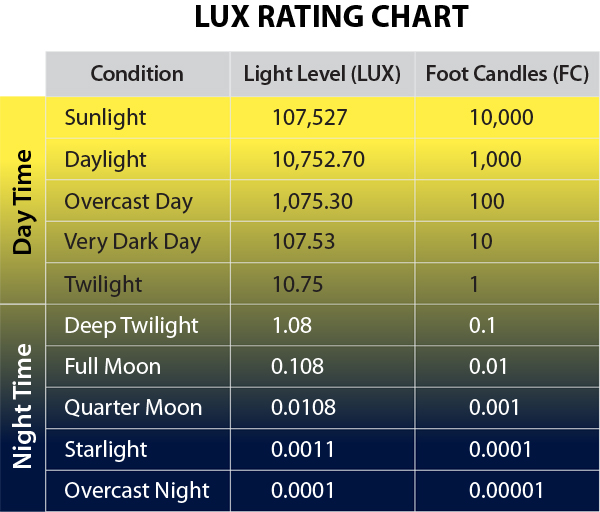Without the sun, Earth would have no source of energy to keep biochemical processes going, and life would not exist. One feature of the sun’s enormous energy is the amount and quality of light it puts out.
Visible light makes up only a small fraction of electromagnetic radiation, which also includes radio waves, microwaves, x-rays and other “invisible” waves. Because “visible” is as much a physiological and concern as one of physics per se – after all, the sun existed well before eyes did – some units in physics concerning light account for this, while others deal only with light energy itself.
The foot-candle (or footcandle) is an example of a unit tailored to the power of the human eye, whereas a related unit, the lumen, is more fundamental to physics. If you’re curious how to work between these units, read on.
1 What is lumen?
The lumen (symbol: lm) is the SI derived unit of luminous flux, a measure of the total quantity of visible light emitted by a source per unit of time. Luminous flux differs from power (radiant flux) in that radiant flux includes all electromagnetic waves emitted, while luminous flux is weighted according to a model (a “luminosity function”) of the human eye’s sensitivity to various wavelengths. Lumens are related to lux in that one lux is one lumen per square meter.
The lumen is a significant entity: it measures the total amount of visible light emitted by a given source. All other measurements are based on the lumen.The lumen measurement originated from the basic concept of foot-candles. It might be illustrated, more or less, by the image shown here. A more scientific definition exists today, but this drawing helps visualize the lumen.
Picture a candle set in the middle of a sphere measuring 0.60 meters (2 feet) in diameter. If we cut a hole that measures 0.09 square meters (1 square foot) in the centre of this sphere, the light that shines through is what we define as a lumen.
A foot-candle equals one lumen per square foot. This is a British measurement. Using the metric system, a lumen is measured by a square meter or a lux. Thus a foot-candle is equivalent to approximately 10 lux or 10.57 lux.
A higher number of lumens are indicative of a brighter, more intense light, whereas a lower number of lumens represent dimmer, more subdued lighting.
2 How to measure a lumen?
In reality, lumens are quite difficult to measure: laboratory tests are usually required. Consequently, if you want to know the number of lumens projected by your lamp or fixture with integrated bulb, you may want to refer to the product packaging or consult the luminaire catalogue.
3 What is foot candle?
You may be wondering, what the heck is a foot candle? Why is this so important? How many foot candles are in my building and how many are required? How do you measure this?
Here is a simple illustration that will help you understand the foot-candle measurement. Imagine setting a candle at a distance of 0.30 meters (1 foot) from a flat wall on which we’ve drawn a square shape measuring 0.09 square meters (1 square foot). One lumen per square foot will illuminate this surface.
Foot candle is commonly used in lighting layouts in parts of the world where United States customary units are used, mainly the United States. Most of the world uses the corresponing SI derived unit lux, defined as one lumen per square meter. Foot-candle is the most widespread lighting measurement in the industry. Why do we still use the word “candle” to measure light in this day and age? The explanation for this choice dates back to the origins of the candle itself. When people began to measure the intensity of light, candles were the most common light source available.
At that time, the candle-making industry provided a consistent, steady, clean, and efficient way to measure light. Thus, we use this well-known expression, even to this day.
4 Typical foot-candle measurements for given light conditions:
- Unobstructed sunlight: 10,000 fc
- Overcast sunlight: 100 fc
- Visually intensive workspace: 200 fc
- Store environment: 5 fc
- Residential space (living): 5-40 fc
- Residential space (working): 70-90 fc
5 What is the purpose of a foot-candle?
So, what is the use of a measurement like foot-candles? Basically, the idea of using foot-candles is to ensure that areas that require certain light levels are actually receiving those light levels.
Offices, manufacturing facilities, and workrooms need significantly higher foot-candle measurements in order to make work easier and less stressful on your eyes.
Hallways and lobbies, on the other hand, need lower foot-candle readings because the light doesn’t need to be bright enough for people hunched over reports and keyboards. Instead, the light level needs to be just bright enough to show off the decor (and bright enough to keep people from tripping over said decor), but not so bright as to feel harsh or sterile.
There are lots of organizations that have special lighting requirements, and foot-candles are the go-to measurement to make sure the right amount of light is actually touching the objects it needs to illuminate.
Museums need specific light levels to create the right ambiance and avoid damaging sensitive artifacts. Horticulture requires very accurate foot-candle readings in order to make sure all plants are bathed in the appropriate amount (and type) of light. Movie and video producers carry little meters with them to check foot-candles on subjects they’re going to shoot.
Any business or organization that has physical security requirements also need to be aware of the foot-candle readings in sensitive areas, and around cameras and doors.
Without light, we simply can’t live and work the way we need to. If you have special requirements for how much light needs to be hitting a given space, you’ll want to know how many foot-candles are shining on that space.
6 How to measure the foot candle?
Step 1: Measuring the Light Intensity
I will use the light meter to measure the number of foot-candles that there are hitting the subject. Once I have this number, I can then use it to convert it into Lumens or Watts depending on whichever method is preferred. For the case of this example, we will base our calculations on a measurement of 50 foot-candles.
Step 2: Converting to Lumens
Please note that one foot-candle = 10.76 Lumens*, which means that in order to convert foot-candles to lumens, I would need to take the amount of foot-candles that I measured, 50 foot-candles ,and multiply by 10.76 to get the number of lumens (50 x 10.76 = 538 lumens)
A lumen is the same as Lux and is what many modern light meters will calculate their measurement in.
Step 3: Converting to Watts
The next step is to calculate the number of watts. One lumen is = 0.001496 watts. This is pretty simple, after you have your total number of lumens from step 2. You take the total number of lumens and multiply it by 0.001496 watts (538 x 0.001496 = 0.805 watts/square meter).
7 Conclusion
Congratulations! You already know about how to convert foot-candles to lumens (Lux) and Watts:
A To calculate Lumens (Lux) from foot-candles: Lumens = Foot Candles x 10.76
B To calculate Watts from foot-candles: Watts = Lumens x 0.001496
C You can also calculate the number of watts directly from foot-candles by combining both equations & using the following: Watts = Foot Candles x 0.01609696
(since 10.76 x 0.001496 = 0.01609696)











